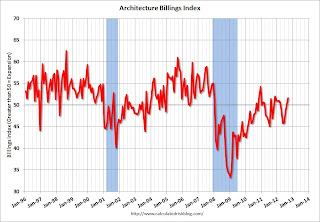by Calculated Risk on 10/24/2012 04:08:00 PM
Wednesday, October 24, 2012
AIA: Architecture Billings Index increases in September
Note: This index is a leading indicator primarily for new Commercial Real Estate (CRE) investment.
From AIA: Increase for Architecture Billings Index
The American Institute of Architects (AIA) reported the September ABI score was 51.6, up from the mark of 50.2 in August. This score reflects an increase in demand for design services (any score above 50 indicates an increase in billings). The new projects inquiry index was 57.3, compared to a mark of 57.2 the previous month.
“Going back to the third quarter of 2011, the multi-family residential sector has been the best performing segment of the construction field,” said AIA Chief Economist, Kermit Baker, PhD, Hon. AIA. “With high foreclosure levels in recent years, more stringent mortgage approvals and fewer people in the market to buy homes there has been a surge in demand for rental housing. The upturn in residential activity will hopefully spur more nonresidential construction.”
Sector index breakdown: multi-family residential (57.3), institutional (51.0), commercial / industrial (48.4), mixed practice (47.8)
 Click on graph for larger image.
Click on graph for larger image.This graph shows the Architecture Billings Index since 1996. The index was at 51.6 in September, up from 50.2 in August. Anything above 50 indicates expansion in demand for architects' services.
This increase is mostly being driven by demand for design of multi-family residential buildings - and this suggests there are more apartments coming (there are already quite a few apartments under construction). Note: This includes commercial and industrial facilities like hotels and office buildings, multi-family residential, as well as schools, hospitals and other institutions.
According to the AIA, there is an "approximate nine to twelve month lag time between architecture billings and construction spending" on non-residential construction. This suggests increase in CRE investment next year (it will be some time before investment in offices and malls increases).
Earlier:
• New Home Sales at 389,000 SAAR in September
• New Home Sales and Distressing Gap
• New Home Sales graphs


